In today’s competitive landscape, businesses must adapt their marketing strategies to meet the evolving needs and preferences of their target audiences. Marketing customization has emerged as a powerful tool for enhancing customer engagement, fostering loyalty, and driving revenue growth. By tailoring marketing efforts to individual customers or specific segments, companies can create more relevant and impactful experiences that resonate deeply with their audiences. This comprehensive guide explores the significance of marketing customization, presents key strategies to implement it effectively, and highlights how Prism Reach, an innovative AI-powered SaaS solution, can elevate your marketing customization efforts.
Key Facts and Statistics
Understanding the impact of marketing customization is supported by compelling statistics:
- Customer Engagement: Personalized marketing can increase customer engagement by up to 50%.
- Conversion Rates: Marketing customization can boost conversion rates by as much as 202%.
- Customer Satisfaction: 80% of consumers are more likely to make a purchase when brands offer personalized experiences.
- Revenue Growth: Personalized marketing strategies can drive a 15-20% increase in revenue.
- Customer Retention: Personalized experiences can improve customer retention rates by up to 5%, resulting in an increase in profits by 25% to 95%.
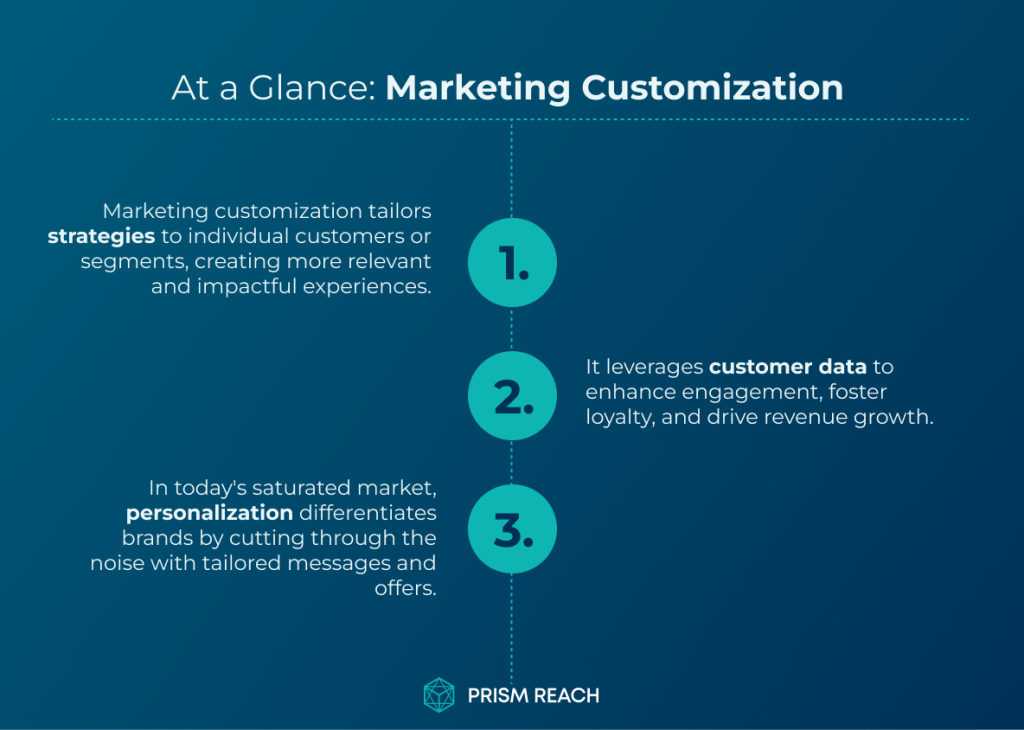
Understanding Marketing Customization
Marketing customization involves tailoring marketing efforts to individual customers or specific segments based on their unique preferences, behaviors, and needs. This approach ensures that marketing messages are relevant, timely, and engaging, leading to improved customer experiences and stronger brand loyalty.
Segmentation
Segmentation is the foundation of effective marketing customization. It involves dividing your customer base into distinct groups based on shared characteristics such as demographics, psychographics, behaviors, and interests. By creating well-defined segments, businesses can develop targeted marketing strategies that resonate with each group’s specific needs and preferences.
- Demographic Segmentation: Dividing customers based on age, gender, income, education, etc.
- Psychographic Segmentation: Categorizing customers based on values, interests, lifestyles, and personalities.
- Behavioral Segmentation: Grouping customers based on their interactions with the brand, purchase history, and engagement levels.
- Interest-Based Segmentation: Segmenting customers based on specific product categories or content preferences.
Personalization
Personalization takes marketing customization to the next level by tailoring experiences to individual customers. It involves using customer data to deliver highly relevant and targeted marketing messages, offers, and experiences that align with each customer’s unique preferences and behaviors.
- Personalized Email Content: Customizing email subject lines, greetings, and content based on subscriber data.
- Product Recommendations: Suggesting products based on a customer’s past purchases and browsing history.
- Customized Website Experiences: Adapting website content and layout to match individual visitor preferences.
- Targeted Advertising: Delivering ads that are specifically relevant to a customer’s interests and behaviors.
Customer Journey Mapping
Customer journey mapping is the process of analyzing and optimizing the customer experience across various touchpoints and interactions with a brand. It involves understanding the customer’s needs, behaviors, and emotions at each stage of their journey, from initial awareness to post-purchase engagement.
- Awareness Stage: Engaging potential customers with personalized content that introduces them to the brand.
- Consideration Stage: Providing tailored information and offers to help customers evaluate products or services.
- Decision Stage: Delivering targeted incentives and personalized support to encourage purchases.
- Post-Purchase Stage: Engaging customers with personalized follow-ups, loyalty programs, and feedback requests.
Upgrade Your Email Marketing with AI Personalization!
5 Hidden Gem Strategies to Leverage Marketing Customization
Maximizing the impact of marketing customization requires innovative strategies that go beyond conventional approaches. Here are five hidden gem strategies that can significantly enhance your marketing effectiveness:
Utilize Zero-Party Data
Strategy: Encourage customers to share their preferences and interests directly through surveys or quizzes, creating zero-party data that can inform personalized marketing efforts.
- Effectiveness: High; this data is explicitly provided by customers, leading to more accurate personalization.
- Obscurity: Many brands rely heavily on third-party data rather than engaging customers for insights.
- Ease of Implementation: Simple to implement through interactive forms or surveys.
- Uniqueness: Focuses on customer-driven insights rather than inferred data, enhancing trust and engagement.
Example: An online bookstore uses Prism Reach to create engaging quizzes that gather readers’ favorite genres and authors. This zero-party data allows the bookstore to send highly personalized book recommendations and tailored promotional offers, resulting in increased open rates and sales.
Hyper-Personalization with AI
Strategy: Leverage AI algorithms to analyze customer behavior and deliver hyper-personalized content in real-time across various channels.
- Effectiveness: Extremely high; AI can process vast amounts of data quickly, delivering timely and relevant personalization at scale.
- Obscurity: While AI usage is growing, its application specifically for hyper-personalization remains underutilized.
- Ease of Implementation: Requires investment in AI tools but offers significant long-term benefits once integrated.
- Uniqueness: This approach takes personalization to an advanced level not commonly practiced.
Example: A fashion retailer integrates Prism Reach’s AI capabilities to analyze customer browsing and purchase history. The AI delivers real-time personalized product recommendations on the website and in email campaigns, enhancing the shopping experience and increasing conversion rates.
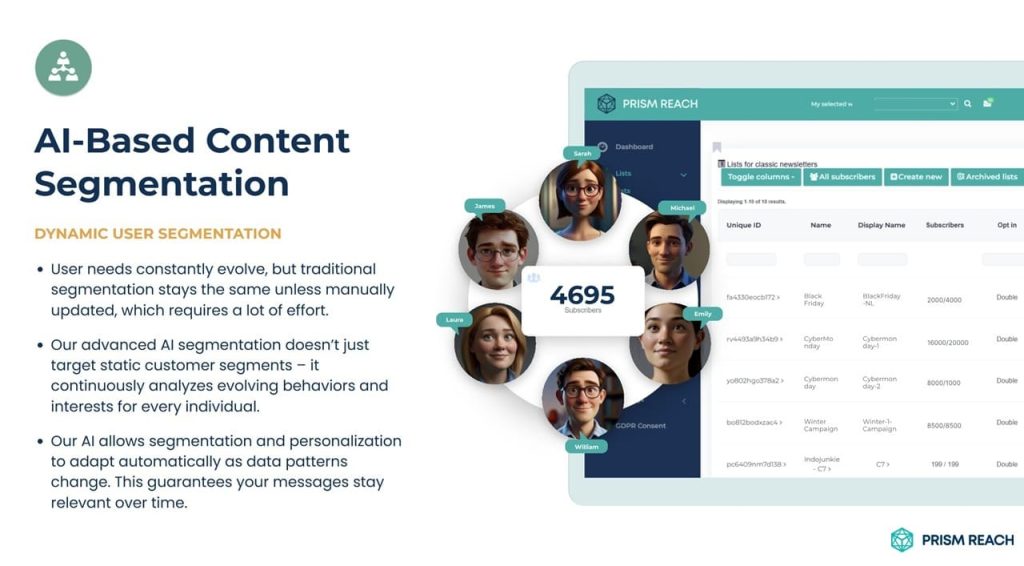
Interactive Content Marketing
Strategy: Create interactive content (e.g., quizzes, polls, calculators) that engages users and allows for tailored recommendations based on their responses.
- Effectiveness: Interactive content can lead to higher engagement rates and better data collection for personalization.
- Obscurity: Many marketers focus on static content without exploring the benefits of interactive formats.
- Ease of Implementation: Requires creative design but can be integrated into existing campaigns with the right tools.
- Uniqueness: This strategy transforms standard marketing interactions into engaging experiences that provide valuable insights.
Example: A health and wellness brand uses Prism Reach to create interactive quizzes that help users identify their fitness goals. Based on quiz results, the brand sends personalized workout plans and product recommendations, enhancing user engagement and driving sales.
Omnichannel Personalization
Strategy: Ensure a seamless experience across all channels by personalizing interactions based on customer behavior and preferences at each touchpoint.
- Effectiveness: Omnichannel personalization can increase customer satisfaction and retention rates significantly.
- Obscurity: While omnichannel strategies are common, the depth of personalization across channels is often lacking.
- Ease of Implementation: Requires coordinated efforts across departments but can be managed with the right technology.
- Uniqueness: This approach emphasizes consistency in messaging while tailoring experiences to individual customer journeys.
Example: A cosmetics brand uses Prism Reach to synchronize customer data across email, social media, and their mobile app. Personalized messages and offers are consistently delivered across all channels, ensuring a cohesive and tailored experience that boosts customer loyalty and sales.
Customer Journey Mapping
Strategy: Map out the entire customer journey to identify key touchpoints where customization can enhance the experience.
- Effectiveness: Understanding the journey allows for targeted interventions that improve customer experience and retention.
- Obscurity: Many marketers overlook this strategic analysis in favor of generic approaches.
- Ease of Implementation: Requires thoughtful planning but can be very effective once established.
- Uniqueness: This strategy integrates marketing strategy with user experience design.
Example: An eCommerce platform utilizes Prism Reach to map out customer journeys from initial website visit to post-purchase follow-up. By identifying key touchpoints, the platform implements personalized email triggers and targeted offers that guide customers smoothly through their buying journey, enhancing satisfaction and increasing repeat purchases.
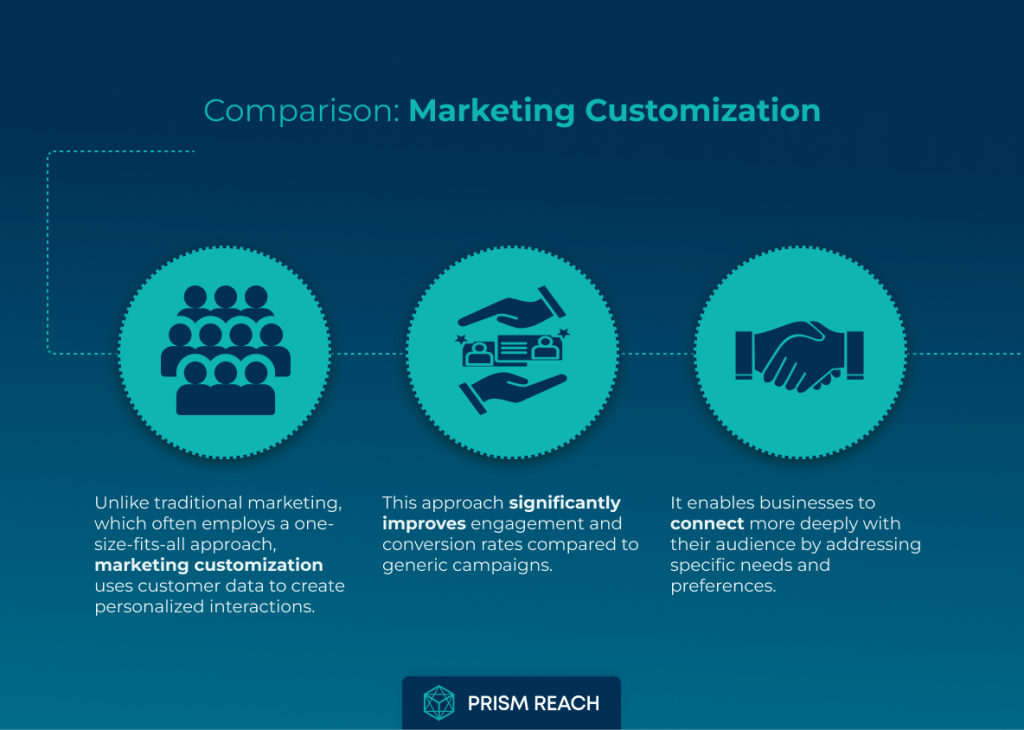
Benefits of Using Prism Reach in Marketing Customization
Integrating advanced tools like Prism Reach into your marketing customization strategies can significantly amplify their effectiveness. Prism Reach offers a suite of features designed to enhance personalization, streamline campaign management, and provide actionable insights that drive better marketing outcomes. Here are three key benefits of using Prism Reach in marketing customization:
1. Enhanced Personalization Through AI
Prism Reach utilizes sophisticated AI algorithms to create detailed user avatars based on subscriber behavior and preferences. This level of personalization is crucial for effectively reaching and engaging diverse audiences.
- Tailored Content: AI-driven personalization ensures that each subscriber receives content that is relevant to their unique preferences and interests.
- Behavioral Insights: By analyzing patterns in subscriber behavior, Prism Reach can predict future actions and tailor marketing messages accordingly, increasing the likelihood of positive engagement.
- Cultural Sensitivity: Personalized content respects and reflects the cultural nuances of different demographic groups, fostering a deeper connection with diverse audiences.
Example: A global apparel brand uses Prism Reach to segment its email list based on cultural preferences and purchase history. The AI personalizes each email with culturally relevant product recommendations and messaging, resulting in higher open and conversion rates across diverse markets.
2. Dynamic Content Selection Tailored to Diverse Audiences
Prism Reach’s ability to dynamically select and tailor content based on real-time data ensures that your emails remain relevant and engaging to a diverse audience.
- Real-Time Adaptation: The platform continuously updates content based on the latest subscriber interactions and feedback, keeping your campaigns fresh and responsive to changing preferences.
- Localized Content: Prism Reach can automatically adjust content to align with local cultural events, holidays, and trends, enhancing the relevance of your marketing messages.
- Inclusive Messaging: Dynamic content ensures that marketing messages are inclusive and considerate of diverse perspectives, avoiding one-size-fits-all approaches.
Example: An international food brand leverages Prism Reach to customize its email content based on regional dietary preferences and cultural festivities. During Ramadan, the platform automatically highlights products and recipes that cater to fasting practices, increasing engagement and sales in Muslim-majority regions.
3. Comprehensive Performance Monitoring for Inclusive Campaigns
Prism Reach provides robust tracking tools to monitor the effectiveness of your email campaigns, ensuring that your marketing customization strategies are yielding the desired results.
- Demographic Analytics: The platform offers detailed insights into how different demographic segments are interacting with your campaigns, allowing for data-driven adjustments to improve effectiveness.
- Engagement Metrics: Track key performance indicators such as open rates, click-through rates, and conversion rates across diverse groups to identify what resonates most with each segment.
- Feedback Integration: Prism Reach can incorporate direct feedback from subscribers to refine and enhance your marketing strategies continuously, ensuring ongoing alignment with diverse audience needs.
Example: A multinational electronics company uses Prism Reach to analyze engagement metrics from its diverse customer base. Insights reveal that certain product categories perform better with specific demographic groups, allowing the company to tailor future campaigns to highlight these products more prominently within those segments, thereby maximizing relevance and impact.
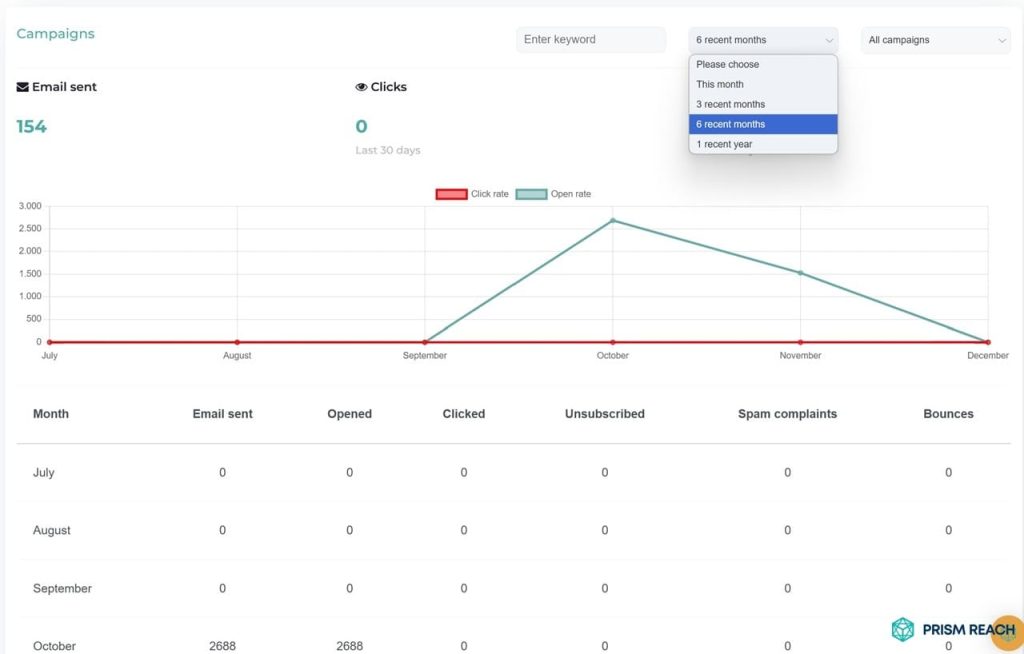
Practical Tips for Enhancing Marketing Customization in Email Marketing
To effectively enhance marketing customization in your email marketing efforts, consider the following practical tips. These strategies will help ensure that your campaigns are inclusive, culturally sensitive, and highly engaging for a diverse audience:
1. Personalization Techniques
- Use Subscriber Data to Personalize Content: Leverage demographic and behavioral data to create personalized subject lines and email content that reflect the unique backgrounds and interests of your subscribers.
- Segment Your Audience: Divide your email list into segments based on factors such as ethnicity, gender, age, and cultural preferences. This allows for more targeted and relevant messaging.
- Implement Dynamic Content Blocks: Use dynamic content blocks that adapt to individual subscriber interests, ensuring that each email delivers content that is meaningful and engaging to the recipient.
Example: A global travel agency uses Prism Reach to segment its email list by region and cultural preferences. Personalized emails include travel packages that cater to specific cultural festivals and holidays, increasing relevance and engagement among diverse subscribers.
2. Automation Best Practices
- Set Up Automated Workflows: Create automated email workflows that include welcome series, cultural event greetings, and post-purchase follow-ups tailored to different demographic groups.
- Optimize Send Times: Use predictive analytics to determine the best times to send emails to different segments, considering factors such as time zones and cultural schedules.
- Automate Cross-Selling and Upselling: Develop automated campaigns that recommend products based on customer behavior and preferences, ensuring that recommendations are culturally relevant and personalized.
Example: An online bookstore employs Prism Reach to automate personalized recommendations based on customers’ previous purchases and cultural interests. During Diwali, the system sends automated emails featuring books by South Asian authors, enhancing relevance and boosting sales in that segment.
3. Continuous Improvement and Adaptation
- Analyze Campaign Performance: Regularly review performance metrics across different demographic segments to identify what works and what needs improvement.
- Gather and Integrate Customer Feedback: Use surveys, polls, and direct feedback to understand the preferences and experiences of your diverse audience, and adjust your strategies accordingly.
- Stay Updated with Trends and Technologies: Keep abreast of the latest email marketing trends and technologies that support inclusivity and personalization, ensuring your campaigns remain effective and relevant.
Example: A fitness brand uses Prism Reach to continuously monitor the performance of its diverse email campaigns. Feedback collected through integrated surveys reveals a high demand for workout plans tailored to different cultural practices, prompting the brand to develop and promote culturally specific fitness programs.
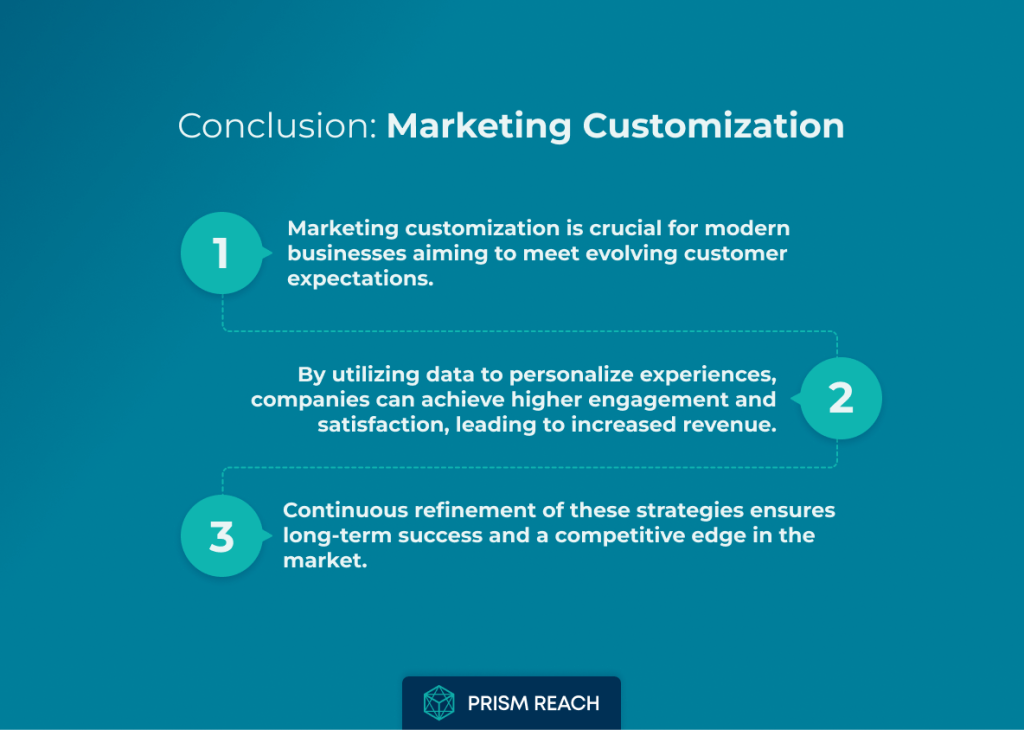
Conclusion
Marketing customization has become a critical component of modern marketing strategies. By leveraging customer data, advanced technologies, and personalized approaches, businesses can create more relevant and impactful experiences that resonate deeply with their target audiences. The five hidden gem strategies outlined above—Utilize Zero-Party Data, Hyper-Personalization with AI, Interactive Content Marketing, Omnichannel Personalization, and Customer Journey Mapping—provide a comprehensive framework for maximizing the impact of marketing customization.
Integrating advanced tools like Prism Reach further amplifies these strategies by providing enhanced personalization through AI, dynamic content selection tailored to diverse audiences, and comprehensive performance monitoring for inclusive campaigns. Prism Reach empowers businesses to create highly personalized and culturally relevant email marketing experiences that resonate with individual subscribers, leading to higher engagement, loyalty, and revenue growth.
As businesses navigate the complexities of marketing in a diverse world, prioritizing inclusivity and leveraging the right tools and strategies will be key to achieving sustained success. Embrace the power of marketing customization to create a customer-centric approach that drives engagement, loyalty, and sustained revenue growth.
Sources
- TechTarget: Examples of Personalization Strategies
- Blaze: Customized Marketing Strategies
- Xerago: Effective Marketing Personalization Strategies
- MoEngage: Personalized Marketing Strategies
- SuperOffice: Personalization Strategies